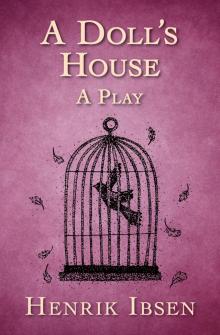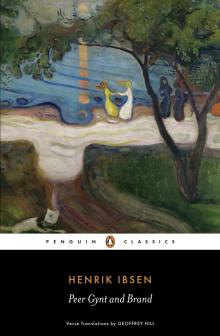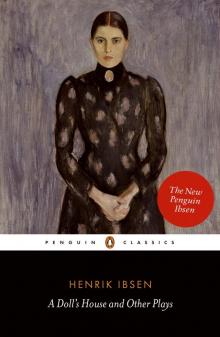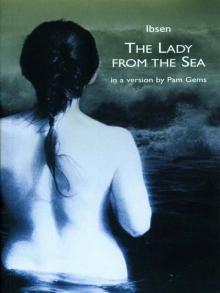- Home
- Henrik Ibsen
The Master Builder and Other Plays Page 3
The Master Builder and Other Plays Read online
Page 3
However much he enjoyed Lugné-Poë’s production, Ibsen was careful not to align himself with one specific aesthetic trend. In particular, he vehemently objected to the idea that his characters were ‘symbolic’ rather than real. In an 1892 letter to the Danish writer and critic Edvard Brandes, who had hailed The Master Builder as a masterpiece, he expressed particular gratitude that Brandes had grasped the play’s most fundamental point, namely that the characters were ‘human beings straight out of real life’.11
Ibsen was right to avoid espousing one aesthetic label over another. The vitality and diversity of aesthetic life in the 1890s revealed Ibsen’s theatrical power and turned him into a classic: by the early 1900s Ibsen’s place in the theatrical canon was largely secure.12
From Obscurity to Difficulty
Ibsen’s late works quickly earned a reputation for obscurity. In response to the late plays, even the Scandinavians, who generally found Ibsen easier to understand than other Europeans, began to refer to him as the ‘Norwegian Sphinx’.13 Modern critics have also consistently found the late plays to be particularly difficult.
A closer look at the reception, however, shows that Ibsen’s contemporaries were not always as puzzled by his late plays as we are today. First of all, in the 1890s, claims about Ibsen’s obscurity were neither ideologically nor aesthetically neutral. A great deal of Ibsen’s reputation for being obscure, enigmatic or plain incomprehensible was the product of anti-Ibsenite hostility to all of Ibsen’s plays. In France, anti-Ibsenites liked to talk about les brumes nordiques – the Nordic fog that they considered fundamentally opposed to French clarity. In such a situation, Ibsen’s supporters may be suspected of declaring his plays clear and straightforward just to spite the opposition.
Regardless of ideological conflicts over Ibsen’s obscurity, it does seem to be true that The Master Builder was perceived as particularly enigmatic by Ibsen’s contemporaries.14 In Norway, one critic complained that the play was nothing but ‘obscure symbolism’, yet acknowledged that this didn’t prevent him from grasping the ‘work’s main idea’.15 One hostile reviewer of the 1893 London production wrote, rather amusingly: ‘But what it all means the trolls only know … What are the “castles in the air”? Why all the prolonged metaphor about “churches,” and “homes for human beings,” and “towers pointing up, up, up”?’16
Ibsen’s Scandinavian contemporaries found Little Eyolf quite easy to understand. The Danish writer Edvard Brandes thought that the play would surely not inspire the same sort of convoluted attempts at clever interpretation as Ibsen’s two previous plays.17 A Danish reviewer declared that John Gabriel Borkman had a clear and straightforward action and was entirely devoid of mysticism and underlying symbolic meanings.18 While a vocal minority held that When We Dead Awaken was overburdened with enigmatic symbols and philosophical reflection, most Scandinavian critics did not complain about obscurity and confidently identified the play’s major themes and preoccupations.19
In contrast, modern Ibsen scholars almost always take Ibsen’s late plays to be both ‘enigmatic’ and ‘challenging’, to quote the Norwegian critic Atle Kittang.20 Strikingly, many of the best modern critics have found Little Eyolf extraordinarily difficult. James McFarlane calls it ‘fearsomely convoluted’, and the Norwegian Frode Helland considers it ‘cryptic to the point of hermeticism’.21
In such reactions we measure the distance between the 1890s and our own time. Ibsen’s contemporaries still generally took clarity to be an unquestioned aesthetic ideal. After modernism, however, ‘challenging’, ‘enigmatic’, ‘ambiguous’, ‘open’ and ‘multi-layered’ have become terms of critical praise. In the 1890s, to call a work ‘obscure’ was to damn it. Today, to call it ‘difficult’ is to praise it.
Late Style: Autobiography, Self-Reflection, Finitude
Whether critics find Ibsen’s last plays clear or obscure, easy or difficult, they agree that they have common preoccupations. All the late plays engage in metatheatrical self-reflection, analyse the creative ambition and the drive for power in men and investigate the role of love in the life of ambitious and powerful men.22 To modern critics, they also raise the question of irony. Do the plays, as most of Ibsen’s contemporaries thought, espouse positive values, such as freedom, creative power or love? Or should we read them, as many modern critics do, as savagely ironic and deeply melancholic negations of all values and ideals?
These themes and questions remain highly relevant for Ibsen’s four last plays, and I will weave them into my exploration of Ibsen’s late style. But I will go beyond them, to investigate finitude and death in these plays. Inspired by some remarks by Edward Said, I shall ask how the ‘decay of the body, the onset of ill health’ – the proximity of death – affects an artist’s style.23 Said was particularly interested in ‘artistic lateness [expressed] as intransigence, difficulty and unresolved contradiction’.24 Nothing exemplifies such a late style better than late Ibsen, Said writes, for his ‘final works, especially When We Dead Awaken, tear apart the career and artist’s craft and reopen the questions of meaning, success and progress’.25 As he wrote On Late Style, Said was suffering from leukaemia. He died before he could write more on Ibsen. I shall show that his intuition that Ibsen’s awareness of his own mortality left a distinctive mark on his 1890s plays is absolutely right.
The frailty – the finitude – of the human body is deeply personal, something the artist experiences in his own body. Does this explain the thematic shift in Ibsen’s late plays? Before Ibsen returned to Norway, he wrote three major plays focused on relatively young female characters: Rebecca West in Rosmersholm, Ellida Wangel in The Lady from the Sea and the eponymous Hedda Gabler. After his return, he began to write about ageing men endowed with varying degrees of creative ambition and power: Halvard Solness, the master builder; Alfred Allmers, the failed philosopher; John Gabriel Borkman, the embezzling titan of finance; and finally, the only artist among them: Arnold Rubek, the celebrated sculptor.
Struck by this thematic shift, some critics have taken Ibsen’s late plays to be autobiographical, expressions of an ageing artist’s relentless self-scrutiny. There are, for example, obvious parallels between Solness’s fascination with Hilde Wangel and Ibsen’s own infatuation with a series of young women in this period: Emilie Bardach, Rosa Fittinghoff, Hildur Andersen and others. We also know that Ibsen began to write When We Dead Awaken only after first toying with the idea of writing an autobiography.26
Yet for Ibsen the personal was not the private. We should remember that the generally Sphinx-like Ibsen considered that to write (å digte) was to give form to something the writer had ‘lived through’ (gjennemlevet): ‘Nobody can give poetic form to anything unless he has – to a certain degree, or at least from time to time – the model within himself.’27 For him, however, the kind of personal experience a writer draws on is always shared with his fellow countrymen: ‘For if that weren’t the case, what would then construct the bridge of understanding between the one who brings forth and those who receive?’28 The challenge is to find a way to read late Ibsen that fully acknowledges the personal, the ‘lived-through’ aspects of these plays, without ever descending to the merely private.
If Ibsen’s late style is an effect of his awareness of death, his late plays can be read as meditations on human finitude. By finitude I understand above all the fact that we are mortal: the frail and suffering human body is the best emblem of human finitude. But to have a finite body also means that we are existentially alone, separated from others. To acknowledge finitude is not just to acknowledge death, but the need to find a way to live with others.29 Sexuality is deeply bound up with our mortality and our separation from others. It can be used either to connect us to others or to isolate us from them, to affirm or deny our mortality. Ibsen’s four late plays work through different ways to deal with human finitude with consummate mastery. In so doing, Ibsen both affirms and denies their personal nature. For finitude is at once personal and universal: nothing could be
more characteristic of humankind, nothing more intimately personal. These plays, then, are deeply personal, yet never private, and never straightforwardly autobiographical, in their explorations of existential attitudes towards human separation and death.
I shall show that in his late plays Ibsen takes a particular interest in characters who deny their finitude. Since the denial of finitude is a form of denial of reality, these plays are intensely concerned with the relationship between reality and fantasy. How do we know what’s real? What happens when we lose touch with reality? Can theatre show us the difference between fantasy and reality? In these plays Ibsen connects his abiding interest in theatre and theatricality with a newly urgent investigation of the meaning of life, and particularly of a creative life, in the presence of death.
The Master Builder: Fantasy and Reality
At first glance, no Ibsen play is more autobiographical than The Master Builder. An older man, Halvard Solness, feels threatened by the rise of the younger generation, incarnated in the young architect, Ragnar Brovik, who works for him. Both Ragnar and his father, Knut Brovik, fear and resent Solness, who refuses to give Ragnar a chance to begin his own practice. Trapped in an empty marriage to his wife Aline, Solness enjoys manipulating the affections of vulnerable young women (exemplified by his bookkeeper, Kaja Fosli) until, inevitably, he gets seriously obsessed with one of them, Hilde Wangel. Many critics have seen parallels between Ibsen and Solness; between Ibsen’s wife Suzannah and Aline; between the young writer, Knut Hamsun, who challenged Ibsen in a series of lectures in Kristiania in 1891, and Ragnar Brovik; and between Ibsen’s constant companion as he wrote the play, the young concert pianist Hildur Andersen, and Hilde Wangel.
Such parallels, however, don’t take us very far. At most, they tell us something about the initial situation of the play. They won’t help us to understand how this play hurls its protagonists towards their tragic end. Nor do we need to know much biography to realize that in The Master Builder Ibsen explores an existential situation which had special resonances for him, namely that of an extremely successful older man, an artist of sorts, who feels ambushed by his age and who is terrified to contemplate his shrinking future.
The Master Builder systematically undermines the distinction between reality and fantasy, both thematically and formally. The play begins with a perfectly realistic office scene, but the moment Hilde Wangel enters, it moves away from realism and towards something else, something new in Ibsen’s writing.30 Thematically, the same movement away from reality towards fantasy is embodied in Solness’s preoccupation with madness. Thus Solness, in somewhat paranoid fashion, is convinced that both his wife and his doctor suspect that he is ‘sick – and deranged – and mad and so on’. At first, we – like Doctor Herdal – see no reason to agree. But as his relationship with Hilde develops, our faith in Solness’s grounding in reality slowly erodes.
Audacious and flirtatious, Hilde turns up with a tale about the past that Solness at first does not remember at all.31 The only thing the two agree on is that, ten years earlier, Solness had built a new church in her home town. According to Hilde, he climbed to the top of the church tower and sang as he stood there, strong and free as a god. At that point, she heard ‘harps playing in the air’. Afterwards, Solness found her alone in a drawing room, grabbed her and kissed her violently. Then he called her his princess, promised her a kingdom and told her that he would come back for her in ten years. Now she has returned, ten years later to the day, to claim her kingdom. Is this true? Or is it just an expression of the wild and alluring Hilde’s own fantasy world? How far can we trust memory, and particularly memory about sex, violence and trauma?
Another man might have suspected Hilde of being mad. Solness, however, is instantly attracted to her. Why? Is it her earthy talk about her dirty underwear? Or rather her lofty invocations of ‘harps playing in the air’? However that may be, the two of them quickly build an erotically charged fantasy world, made up in equal parts of erotic attraction and fantasies about power, a world in which Solness is the omnipotent demiurge, who will build ‘castles in the air’ for Hilde.
In his conversations with Hilde, Solness reveals his complicated, guilt-ridden relationship to his wife Aline. When Aline’s childhood home burned down, Solness got the break he needed to launch his career: he built villas on the land, and those villas assured his reputation. The fire also, indirectly, led to the death of their newborn twins. After the fire, Aline, who was still breastfeeding, caught an infection, which she passed on to her little babies. In spite of firm evidence that the fire had nothing to do with the crack in the chimney, Solness is convinced that he caused the fire because he never fixed it.
In Solness’s fantasy, he is surrounded by invisible ‘helpers and servants’, invisible demonic spirits who do his bidding when he wishes for something with extreme intensity. Thus Solness is convinced that he ‘willed’ Kaja Fosli to come and work for him, just as he ‘willed’ Aline’s childhood home to burn down.
Maybe Hilde imagines the harps in the air, and the kisses in the drawing room, too. Maybe Solness imagines his ‘helpers and servants’. But that makes them a fine pair: they both fear reality so intensely that they retreat into their fantasy kingdom at the slightest provocation. They don’t fear the same aspects of reality, however. For Hilde, sex is the ultimate, traumatic bedrock of existence she at once fears and wants. Solness is desperate to deny death, and anything connected to it. The young Ragnar Brovik is not just Oedipal competition but a reminder of the inexorable march of time. That Ragnar’s father, Knut, is dying during the play reinforces the point. Once the young Solness elbowed Knut Brovik aside; now the time has come for Solness to be displaced by Brovik’s son. At first, Solness takes Hilde’s youth to be the opposite of Ragnar’s: he is aggression and death; she seduction and vitality. In the end, however, Hilde’s absolute refusal to accept reality turns out to be far more dangerous to Solness than Ragnar’s resentment.
Challenged and seduced to prove his virility to Hilde, Solness undertakes to do the impossible: to defy his vertigo and carry a celebratory wreath to the top of the tall tower on his own new house. Solness reaches the top of his high tower, but once he is there, he is overcome with dizziness and falls to his death. Hilde’s frantic waving of Mrs Solness’s white shawl may have contributed to his fall. At the very end of the play Solness is dead, and Hilde is imprisoned in her fantasy kingdom, left alone to speak her ‘bewildered’ words: ‘But he got to the very top. And I heard harps playing in the air’. There is more than a hint of madness here.
Rather than seeing this as a purely negative ending, I read the play as a study of two people’s denial of human finitude.32 This play is obsessed with sex and death, yet Hilde’s and Solness’s fantasy world negates both. Ultimately, Ibsen places the question of death before Solness, before Hilde and before the audience. Can a sexually and professionally powerful man face his own decline? Solness’s refusal to acknowledge the claims of time and youth (embodied in Knut and Ragnar Brovik, respectively) shows the depth of his denial. When Hilde bursts in, he is all primed to fall in with her fantasies about his own timeless power. That she drives him to his death is the ultimate paradox of the play.
Yet Ibsen didn’t necessarily think of this as a disaster, for he once remarked that Hilde’s arrival ‘lifts him [Solness] up higher than before, to do things he had not been able to do for a long time (symbolically). But he stakes his life on it – and is killed. But was it so mad if it cost him his life, if he did it for his own happiness and only then, for the first time, achieved it?’33 According to Ibsen, then, Solness’s end may not even be a tragedy, but a perfectly fine way for a titan to leave the world. This play challenges us to reflect on our own mortality, on the inevitable end of our own projects and ambitions, but it does not follow that it is relentlessly negative.
The end of The Master Builder raises fundamental existential questions: are a life’s achievements still worth caring about when death approaches? How
should we look at young people – those who will remain when we are gone? What happens when we annex them to our own fantasies of immortality and survival? What is the meaning of success and creativity in the shadow of death? Is it possible to find meaning in life when one feels that one’s future is shrinking with every day that passes?
Little Eyolf: From Fantasy to Love and Realism
Little Eyolf continues the preoccupations of The Master Builder, but turns them upside down.34 In their denial of time and death, Solness and Hilde have no thought of others; in Little Eyolf, the characters realize that they must break out of their fantasy world and begin to care about other human beings.
Little Eyolf is the story of the death of a nine-year-old child and its aftermath. Lame in one leg, Eyolf lives with his parents, Alfred and Rita Allmers, in a luxurious mansion overlooking the fjord. Rita, a curvy, sexy, passionate woman, is frustrated with Allmers’s lack of sexual interest in her. Allmers is strongly attached to Asta, his twenty-five-year-old half-sister, who is courted by the road-builder Borgheim. Thanks to Rita’s fortune, Allmers has been able to spend the last ten years following his vocation: to write a grand philosophical tome on human responsibility. As the play begins, Allmers has decided to abandon his book and devote himself to little Eyolf’s education instead. The Rat-Maid, a mysterious character who kills rats by compelling them to jump into the fjord to follow her boat, turns up to ask for work, but receives none. Instead Allmers and Rita begin a quarrel in which Rita comes close to wishing Eyolf dead. At that moment we learn that Eyolf has drowned: he walked off the jetty transfixed by the Rat-Maid rowing away in her little boat.

 A Doll's House
A Doll's House Peer Gynt and Brand
Peer Gynt and Brand The Master Builder and Other Plays
The Master Builder and Other Plays A Doll's House and Other Plays (Penguin)
A Doll's House and Other Plays (Penguin) The Lady from the Sea
The Lady from the Sea